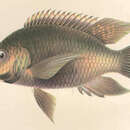Diagnostic Description
provided by Fishbase
Diagnosis: scales of cheek in 2 or usually 3 horizontal rows; in mature males preorbital bone and jaws enlarged; upper profile of head often concave; outermost teeth bicuspid, and inner tricuspid in immature fishes and females, all becoming unicuspids in males; male genital papilla spade-shaped; margins of dorsal and caudal fins red in mature males (Ref. 2).Description: very deep-bodied when adult; mouth relatively small in juveniles, but larger in adults; snout large and possesses a duckbill-like shape, especially in old males (Ref. 52307). Head length 34.0-38.0% SL; lower pharyngeal jaw with unicuspid anterior teeth and straight posterior teeth; ventral keel elongated, as long, or longer, than dentigerous plate; 4-6 rows of teeth in oral jaws, outer row teeth bicuspid (Ref. 81260).Coloration: base body color pale or whitish, light grey dorsally, preorbital olive-green; lips paler than snout; flank scales with central blue-red spot (Ref. 81260). Numerous, irregularly arranged black spots on cheeks (Ref. 52307), opercle (Ref. 52307, 81260) and occiput, concentrated around sensory canal pores (Ref. 81260). Dorsal fin greyish with a large yellowish white distal submargin becoming red marginally; spinous dorsal with some oblique clear lines, very thin between spines, soft dorsal with many clear maculae (Ref. 81260). Caudal fin greyish with many clear maculae, sometimes aligned between rays (Ref. 81260), distal margin red (Ref. 52307, 81260). Anal fin greyish (Ref. 52307, 81260) with some clear maculae between soft rays, proximally tinted red (Ref. 81260). Pelvics whitish to transparent (Ref. 81260). Juveniles: tinted with green, with 6-8 darker vertical bars on the flanks; dorsal, caudal and anal fins greenish grey, with some clear maculae between soft rays; pelvics and pectoral fins transparent (Ref. 81260). Males usually exhibit a red dot at the center of each body scale (Ref. 52307).
Life Cycle
provided by Fishbase
Nests are made on sandy or loamy bottoms in water 40-80 cm deep, or more sparsely in depths of a meter or more; they are circular basins with a diameter of 115-185 cm, about 20 cm deep in the middle with a rim raised 7-8 cm above the surrounding level; spawning occurs at night, the fishes seeking deeper waters during the day to avoid high temperatures and intense illumination (Ref. 2). Reproduction is seasonal, usually taking place during the dry seasons from June to September and in February; can reach maturity at a size of 15 cm; breeding behavior is similar to that of its congeners (e.g. O. niloticus) (Ref. 52307).
- Recorder
- Crispina B. Binohlan
Morphology
provided by Fishbase
Dorsal spines (total): 14 - 16; Dorsal soft rays (total): 12 - 13; Analspines: 3; Analsoft rays: 9 - 11; Vertebrae: 27 - 29
Biology
provided by Fishbase
Occasionally territorial; stomachs contained algae, mainly unicellular or in short filaments (Ref. 2). Arena-spawning, exclusively maternal mouthbrooder with marked sexual dichromatism when sexually active (Ref. 81260).
Importance
provided by Fishbase
aquaculture: likely future use

